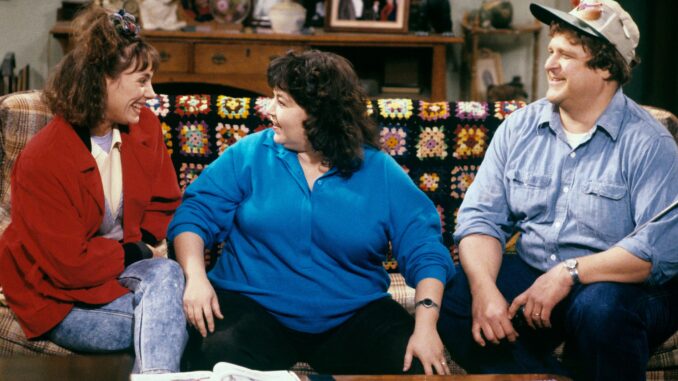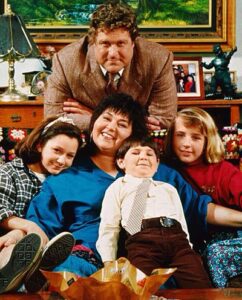
The Enduring Legacy of Roseanne, 30 Years Later
As long as there’s been TV, the family has been one of its favorite go-tos.
A family sits around a cluttered kitchen table, arguing and roughhousing. Finally, the man at the table leans over to smooch his wife. She cheerfully wipes off the kiss, letting loose a peal of bawdy laughter.

That was how America met the Conner family on October 18, 1988. In its minute-long opening sequence, Roseanne conveys a concrete sense of this rambunctious working-class household. There are bills on the table that are probably overdue, and kids interrupting as their parents shrug them off. There are dowdy clothes and bad hair and faded wallpaper. But most of all, there is that glorious laugh of Roseanne’s hanging in the air, a perfect chord of raucousness and affection. It signals a family life bound by love but not muddied by sentimentality.
When it premiered on October 18, 1988, Roseanne was an instant hit: watched by more than 21 million viewers, the debut episode beat the World Series game it was up against (LA Dodgers versus Oakland A’s) to win the night’s ratings.

By the end of the season, it had become the country’s number two prime-time series, topped only by another family sitcom, The Cosby Show. Although there was a small but well-loved lineage of classic comedies set in ordinary American homes, from The Honeymooners to All in the Family, Roseanne depicted a family more real than any seen on television before. And the show’s originality resides above all in the character of Roseanne herself.
No television sitcom had ever revolved around such a fierce, sharp- tongued virago. Take the scene in the first episode in which five women sit around a table during their break from the assembly line at the plastics factory, talking trash about men. One of the workers picks up a chocolate donut and quips, “A guy is a lump, like this donut. Okay. So, first, you gotta get rid of all this stuff his mom did to him,” she says, flicking toppings off the donut’s surface. “Then you gotta get rid of all that macho crap that they pick up from the beer commercials. And then, there’s my personal favorite, the male ego,” she says, devouring a chunk of the donut with a mischievous wrinkle of her nose.
Roseanne appeared at a time of economic uncertainty, as the stock market crash of October 1987 curtailed the greedy, Dynasty-style excesses of the Reagan era. Rarely had the American working class had such poignantly authentic representatives on TV. But the series made viewers laugh more often than cry with its stinging one-liners.
“Mother … our school’s having a food drive for poor people,” daughter Becky tells Roseanne. “Tell ’em to drive some of that food over here,” she snaps back. When young son DJ finds an unemployed Roseanne trying to sell magazine subscriptions by phone, he asks what she’s working on. She doesn’t miss a beat: “I’m ordering new children.”

The series often played up the shtick of Roseanne Conner as a “bad mom” — a persona Barr helped propagate and that would pick up speed in pop culture decades later, in books such as Ayelet Waldman’s 2009 memoir Bad Mother and the 2016 movie Bad Moms, with women coolly wearing the term as a badge of honor. A refusal of the whole “having it all” con, it became a way of pushing back against the guilt and unrealistic expectations of perfect motherhood. Why pretend you’d rather change a baby’s diaper than kick back with a margarita? As Waldman wrote, “We shrug at the orange Cheetos dust smeared across our children’s mouths … happy to confess our sins because we are confident that those who come closest, and with the most sanctimony, to emulating the self-effacing, self-sacrificing, soft-spoken, cheerful, infinitely patient Good Mother are the real Bad Mothers.”
